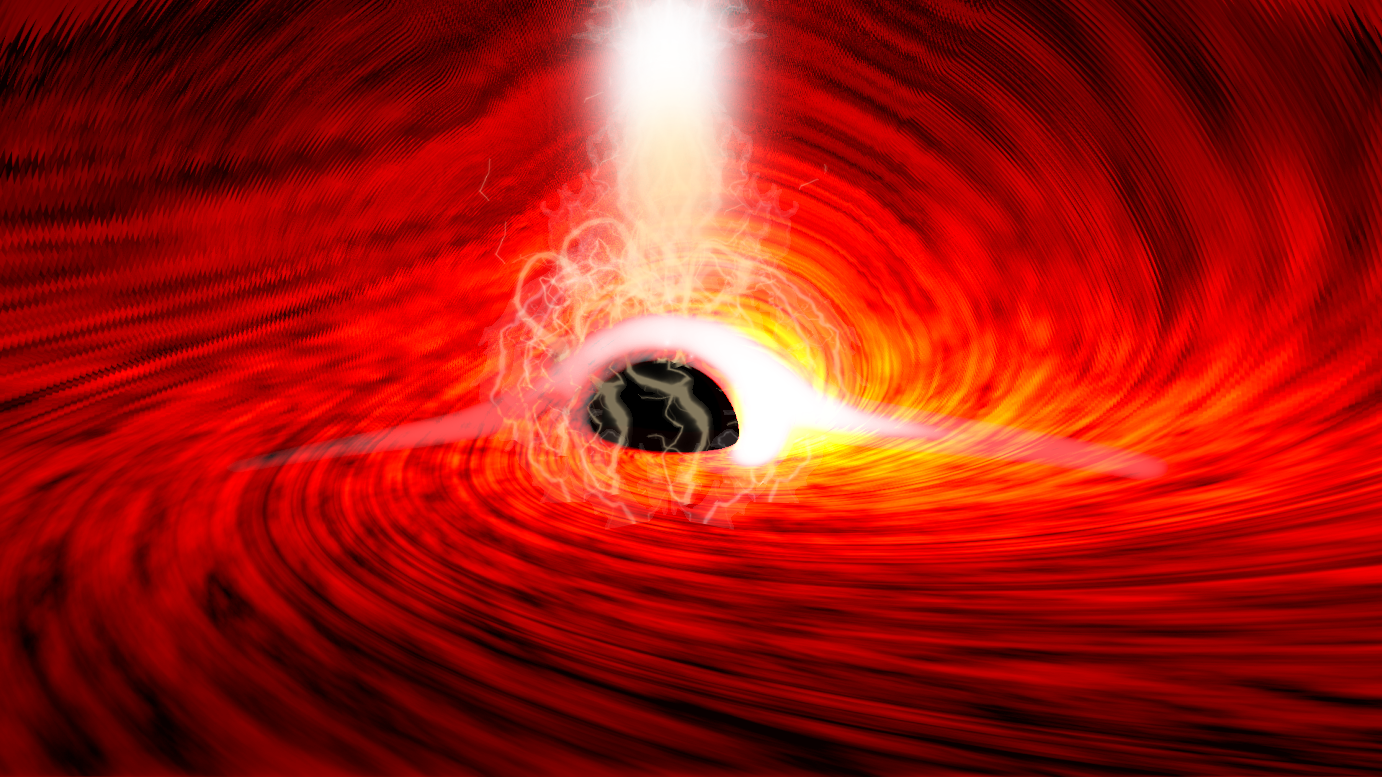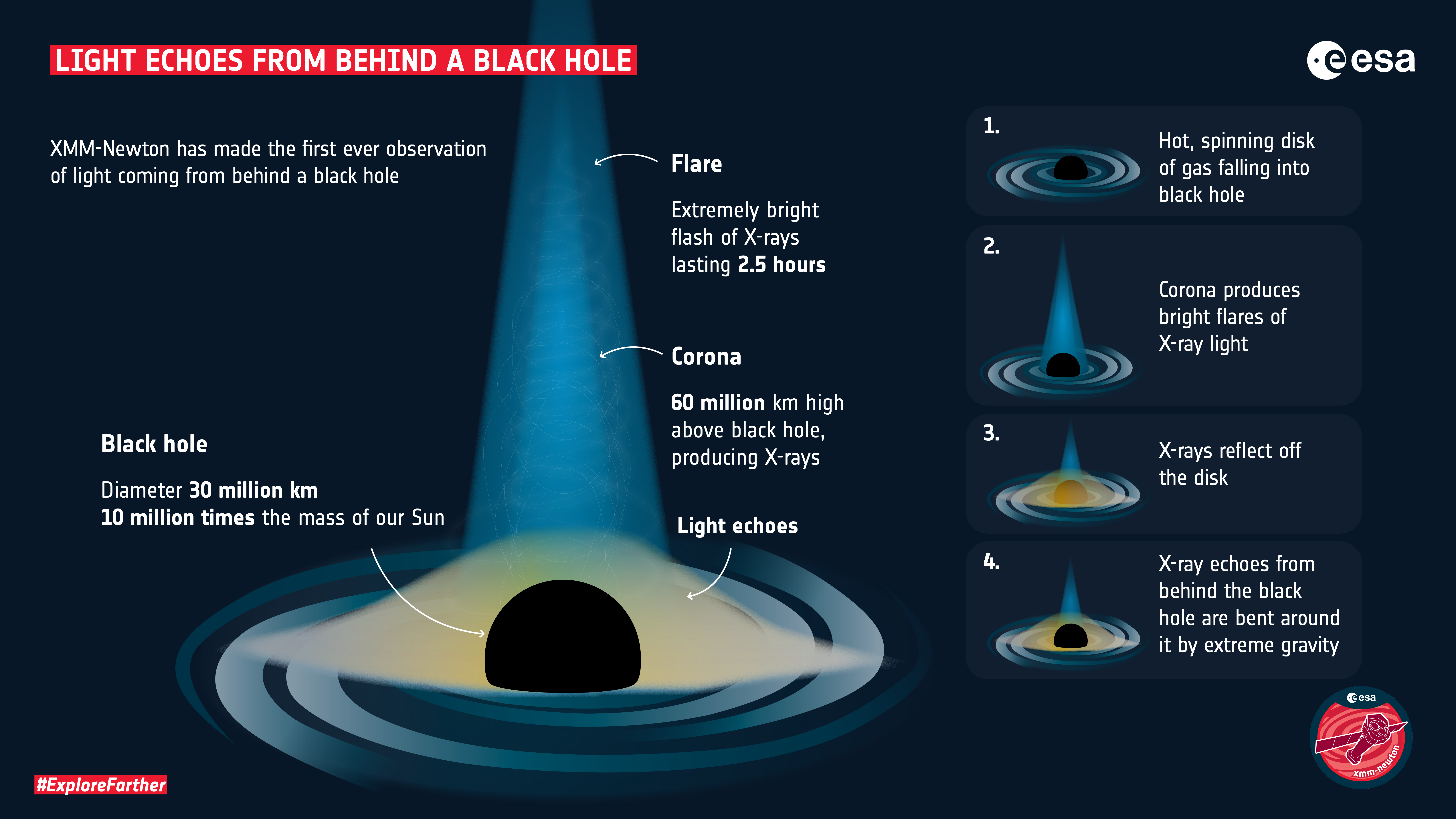Een internationaal team van astronomen, waaronder Elisa Costantini (SRON), heeft voor het eerst licht waargenomen afkomstig van de achterkant van een zwart gat. Deze straling komt oorspronkelijk uit de corona rondom het zwarte gat, als röntgenstraling. Na een reeks sterke röntgenflitsen vanaf de voorkant volgde een serie zwakke flitsen, die vanaf de achterkant moeten zijn weerkaatst op de accretieschijf rond het zwarte gat. Publicatie in Nature.
Terwijl de onderzoekers een superzwaar zwart gat bekeken dat lustig röntgenstraling aan het rondstrooien was in het centrum van een sterrenstelsel hier 800 miljoen lichtjaar vandaan, viel ze een interessant patroon op. Ze zagen een reeks heldere röntgenflitsen—spannend, maar niet ongehoord—en toen ving de telescoop iets onverwachts op: een stel röntgenflitsen die zwakker, later en van een andere golflengte waren.
De oorspronkelijke motivatie achter het onderzoek was om een mysterieuze eigenschap van veel zwarte gaten te onderzoeken: zijn corona. Als kosmisch gas richting een superzwaar zwart gat valt vormt het een zogenoemde corona rondom het zwarte gat, waarbij het röntgenstraling uitzendt. Dit röntgenlicht kan worden bestudeerd om een zwart gat te karakteriseren en in kaart te brengen.
Het gas binnen een corona wordt miljoenen graden heet; genoeg om elektronen van atomen te scheiden, zodat er een gemagnetiseerd plasma ontstaat. De magnetische veldlijnen zitten gevangen in de krachtige rotatie van het zwarte gat, waardoor ze zodanig opgewonden en verstrikt raken dat ze uiteindelijk breken. Dit proces is zo vergelijkbaar met wat er rondom onze Zon gebeurt dat het dezelfde naam heeft gekregen: corona.
Voor hun onderzoek richtten de astronomen de ruimtetelescopen NuSTAR (NASA) en XMM-Newton (ESA) op het sterrenstelsel I Zwicky 1. Ze detecteerden een reeks röntgenflitsen, en terwijl ze die bestudeerden merkten ze een serie zwakkere flitsen op. Ze kwamen erachter dat dit dezelfde flitsen zijn, maar dan van de achterkant, als echo teruggekaatst op de accretieschijf rond het zwarte gat—een eerste glimp van de achterkant van een zwart gat.
‘Hoewel we eraan gewend zijn dat accretieschijven vaak flitsen uitzenden en grillig gedrag vertonen, was dit de eerste keer dat we er een paar van konden gebruiken om de achterkant van het zwarte gatsysteem op te sporen,’ zegt Costantini. ‘Dit zou een nieuw hoofdstuk kunnen inluiden voor het onderzoek naar accretieschijven.’
De toekomstige Athena-röntgentelescoop, die in 2031 wordt gelanceerd en waar SRON belangrijke bijdragen aan levert, biedt mogelijkheden om corona’s rond zwarte gaten tot in nog meer detail te bestuderen.

Dit onderzoek is uitgevoerd onder leiding van Stanford University. Co-auteurs zijn aangesteld bij Saint Mary’s University, SRON Netherlands Institute for Space Research, Universiteit van Amsterdam and The Pennsylvania State University.
Onderschrift header image: Illustratie van een zwart gat dat een röntgenflits uitzendt vanuit zijn corona, die vervolgens door de accretieschijf rondom wordt weerkaatst. Uiteindelijk buigt de extreme zwaartekracht het röntgenlicht om het zwarte gat, naar onder meer de Aarde. Credit: Dan Wilkins/Stanford
Publicatie
Wilkins D., Gallo L., Costantini E., Brandt W., Blandford R., ‘Light Bending and X-ray Echoes from Behind a Supermassive Black Hole‘, Nature
First detection of light from behind a black hole
An international team of astronomers, including Elisa Costantini (SRON), has for the first time observed light from the far side of a black hole. Initially this light, in the form of X-rays, is emitted by a corona surrounding the black hole. A series of strong X-ray flashes from the front was followed by a series of weaker flashes, which the researchers determined are from the back side and reflected off the black hole’s accretion disk. Publication in Nature.
Watching X-rays flung out into the Universe by the supermassive black hole at the center of a galaxy 800 million light-years away, the research team noticed an intriguing pattern. They observed a series of bright flares of X-rays – exciting, but not unprecedented – and then, the telescopes recorded something unexpected: additional flashes of X-rays that were smaller, later and of different wavelength than the bright flares.
The original motivation behind the research was to learn more about a mysterious feature of many black holes, called a corona. Material falling into a supermassive black hole powers the brightest continuous sources of light in the Universe, and as it does so, forms a corona around the black hole. This light – which is X-ray light – can be analyzed to map and characterize a black hole.
The leading theory for what a corona is starts with gas sliding into the black hole where it superheats to millions of degrees. At that temperature, electrons separate from atoms, creating a magnetized plasma. Caught up in the powerful spin of the black hole, the magnetic field arcs so high above the black hole, and twirls about itself so much, that it eventually breaks altogether – a situation so reminiscent of what happens around our own Sun that it borrowed the name “corona”.
For this project, the researchers trained two space-based X-ray telescopes, NASA’s NuSTAR and the European Space Agency’s XMM-Newton, on the galaxy known as I Zwicky 1. They detected a series of X-ray flares, and while taking a closer look to investigate their origin, they saw the series of smaller flashes. These, the researchers determined, are the same X-ray flares but reflected from the back of the black hole’s accretion disk—a first glimpse at the far side of a black hole.
‘Although we are used to accretion disks flaring quite often and with an erratic behavior, this was the first time that some of those flashes could be effectively used to trace the far side of the black hole system,’ says Costantini. ‘This may open a new window on accretion disks studies.’
The future Athena X-ray telescope, to be launched in 2031 and with significant contributions from SRON, offers the possibility to study coronas around black holes in even more detail.
This study was led by Stanford University. Co-authors of this research are from Saint Mary’s University, SRON Netherlands Institute for Space Research, University of Amsterdam and The Pennsylvania State University.
Publication
Wilkins D., Gallo L., Costantini E., Brandt W., Blandford R., ‘Light Bending and X-ray Echoes from Behind a Supermassive Black Hole‘, Nature


